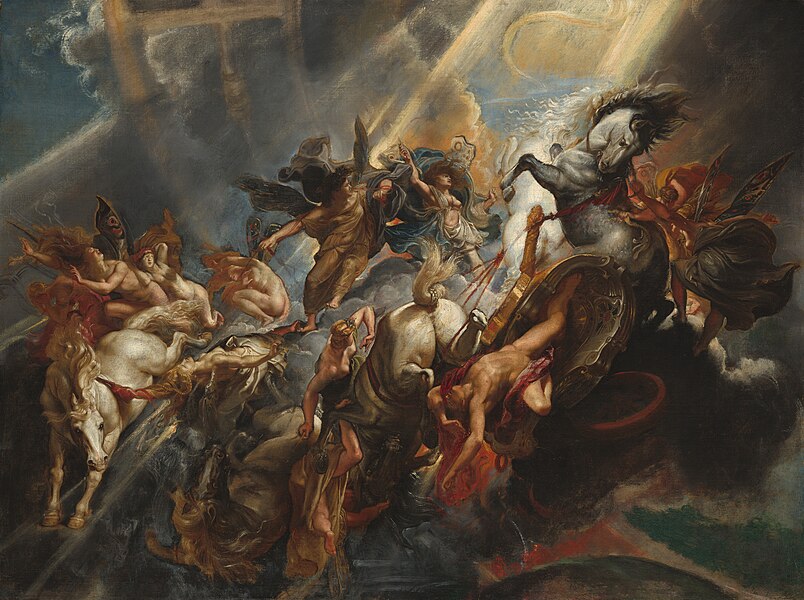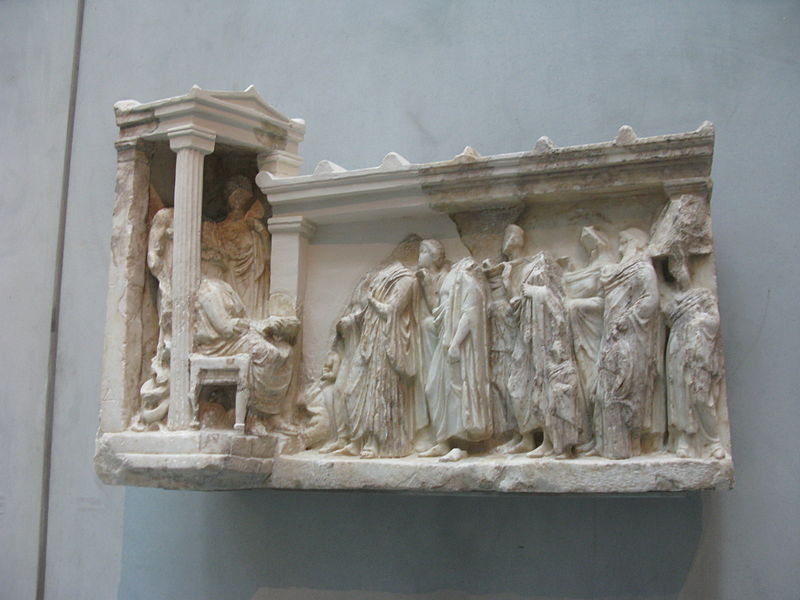 1
1title: Glaukos et Polyeides in the grave (cup 07)
artist:
Sotades-Malerdate: 460-450 BCE
medium: de 1=Keramik en 1=Pottery fr 1=Céramique
dimensions: de 1=Durchmesser 13 cm, Höhe 8 cm. en 1=Diameter 13 cm, height 8 cm. fr 1=Diamètre 13 cm, hauteur 8 cm.
current location: <!-- location within the museum --> Institution:British Museum
source: Yorck
credit: The Yorck Project () 10.000 Meisterwerke der Malerei (DVD-ROM), distributed by DIRECTMEDIA Publishing GmbH. ISBN: 3936122202.
license:Public domain
 2
2title: Peter Paul Rubens The Fall of Phaeton (National Gallery of Art)
artist: Peter Paul Rubens
date: between circa 1604 and circa 1605 , probably reworked between circa 1606 and circa 1608
medium: Oil on canvas
dimensions: size cm 98.4 131.2
current location: Institution:National Gallery of Art
source: [link nga.gov National Gallery of Art, Washington D.C.]
credit: nga.gov National Gallery of Art, Washington D.C.
license:Public domain
 3
3title: Wenceslas Hollar The Greek gods. Jupiter
artist: Wenceslaus Hollar
date: Unknown date (author lived 1607-1677)
dimensions: 7 x 10 cm.
credit:
- Artwork from University of Toronto Wenceslaus Hollar Digital Collection
- Scanned by University of Toronto
- High-resolution version extracted using custom tool by User:Dcoetzee
license:Public domain
 4
4title: Wenceslas Hollar The Greek gods. Neptune
artist: Wenceslaus Hollar
date: Unknown date (author lived 1607-1677)
dimensions: 7 x 10 cm.
credit:
- Artwork from University of Toronto Wenceslaus Hollar Digital Collection
- Scanned by University of Toronto
- High-resolution version extracted using custom tool by User:Dcoetzee
license:Public domain
 5
5title: Wenceslas Hollar The Greek gods. Pluto
artist: Wenceslaus Hollar
date: Unknown date (author lived 1607-1677)
dimensions: 7 x 10 cm.
credit:
- Artwork from University of Toronto Wenceslaus Hollar Digital Collection
- Scanned by University of Toronto
- High-resolution version extracted using custom tool by User:Dcoetzee
license:Public domain
 6
6title: Ancient greek votive relief. 400 BC
artist:
date: 27 June 2009, 15:55:38
source: originally posted to '''[[Flickr|Flickr]]''' as [link Votive relied. 400 BC]
credit: originally posted to Flickr as Votive relied. 400 BC
description: Ancient greek votive relief. 400 BC. Asclepios is sitting on an omphalos between his wife Epione and a man clad in himation. New Acropolis Museum, Athens, Greece.
license:
CC BY-SA 2.0
 7
7title: Ancient greek votive relief. Mid-4th cent. BC
artist:
date: 27 June 2009, 15:55:55
source: originally posted to '''[[Flickr|Flickr]]''' as [link Votive relied in the form of two adjacent buildings, a temple and a stoa. Mid-4th cent. BC]
credit: originally posted to Flickr as Votive relied in the form of two adjacent buildings, a temple and a stoa. Mid-4th cent. BC
license:
CC BY-SA 2.0
 8
8title: Willem Isaacsz. van Swanenburg Paris en Mercurius, 1609
artist: Willem Isaacsz Swanenburg
date: 1609
medium: engraving
dimensions: size unit=mm height=247 width=140
current location: Institution:Rijksmuseum <!-- location within the gallery/museum -->
source: [link]
credit: [1]
license:Public domain
 9
9title: Andromeda and the Sea Monster, and Leda and the Swan, 11364501
artist: Massimiliano Soldani Benzi
date: 1725
source: link
description: Andromeda and the Sea Monster (right); Leda and the Swan (left). Bronze on grey-green marble bases with bronze mounts, 49.6 × 33.3 × 20.7 cm (19 1/2 × 13 1/8 × 8 1/8 in.), designed before 1717; cast about 1725. Object Number: 97.SB.61.1.
As a sea monster lunges towards her, the nude Andromeda recoils, straining against the chains that tie her to the rocky ledge. Her hair blows behind her, indicating sudden movement. The sharp angles of her eyebrows and nose express anxiety, while the diagonal of her body expresses the repulsion she feels towards the growling beast.
Andromeda and the Sea Monster depicts a dramatic moment from the ancient greek author Euripides' tale of Andromeda and Perseus. Andromeda's mother angered the gods with her boast that Andromeda was more beautiful than the Nereids, the attendants of the god of the sea, Poseidon. To appease the offended Poseidon, who threatened to destroy their entire kingdom, Andromeda's parents sacrificed their daughter by leaving her where she would be devoured by his monster. As Andromeda awaits the monster, chained to a rock, Perseus flies overhead, falls instantly in love with her, and rescues her by slaying the beast. Massimiliano Soldani Benzi's interpretation of the story is unusual because he focused on Andromeda's horror at the monster instead of on her rescue.
Master sculptor Massimiliano Soldani Benzi cast the bronze groups of Andromeda and the Sea Monster and Leda and the Swan as pendants. Each depicts an episode from classical mythology, and the two are visually linked by opposing compositions. Leda reclines, forming a diagonal from the lower right to the upper left. This line is balanced by that created by Andromeda—a diagonal moving from the lower left to the upper right—as she attempts to escape. Both figures also display heightened emotion: Leda expresses seductive eroticism, and Andromeda expresses terrifying horror.
Each group retains its original base, golden reddish lacquer patina, and elaborate matching bronze mounts on the base.
Description: [CC-BY-SA-4.0] J. Paul Getty Trust.license:Public domain

title: HouseOfHades
artist: Black Shade9
date: 2018-06-21
source: link
credit: link
description: Faux screencap of a video game set in the greek underworld. Image composed of free license materials. See File:Temple of Augustus and File:Cave interior.jpg.
license:
CC0





